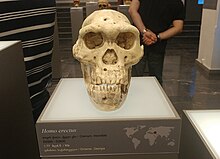 Skull 5 in National Museum | |
| Catalog no. | D4500 |
|---|---|
| Common name | Dmanisi skull 5 |
| Species | Homo erectus |
| Age | 1.8 million years |
| Place discovered | Dmanisi in Georgia |
| Date discovered | 2005 |
| Discovered by | David Lordkipanidze |
The Dmanisi skull, also known as Skull 5 or D4500, is one of five skulls discovered in Dmanisi, Georgia and classified as early Homo erectus. Described in a publication in October 2013, it is estimated to be about 1.8 million years old and is the most complete skull of a Pleistocene Homo species,[1][2] and the first complete adult hominin skull of that degree of antiquity.[3][4] According to researchers, the discovery "provides the first evidence that early Homo comprised adult individuals with small brains but body mass, stature and limb proportions reaching the lower range limit of modern variation."[3]
The skull has been the cause of a paleontological controversy that is still ongoing as of 2017: many hominin fossils thought to be from different species such as Homo rudolfensis or Homo habilis may not have been separate species at all. Rather, they may have been a single evolving lineage.[2]
- ^ David Lordkipanidze, Marcia S. Ponce de Leòn, Ann Margvelashvili, Yoel Rak, G. Philip Rightmire, Abesalom Vekua, Christoph P. E. Zollikofer (18 October 2013). "A Complete Skull from Dmanisi, Georgia, and the Evolutionary Biology of Early Homo". Science. 342 (6156): 326–331. Bibcode:2013Sci...342..326L. doi:10.1126/science.1238484. PMID 24136960. S2CID 20435482.
{{cite journal}}: CS1 maint: multiple names: authors list (link) - ^ a b Skull suggests three early human species were one : Nature News & Comment
- ^ a b Wilford, John Noble (October 17, 2013). "Skull Fossil Suggests Simpler Human Lineage". The New York Times. Retrieved October 18, 2013.
- ^ Watson, Traci (October 17, 2013). "Skull discovery sheds light on human species". USA Today. Retrieved October 18, 2013.